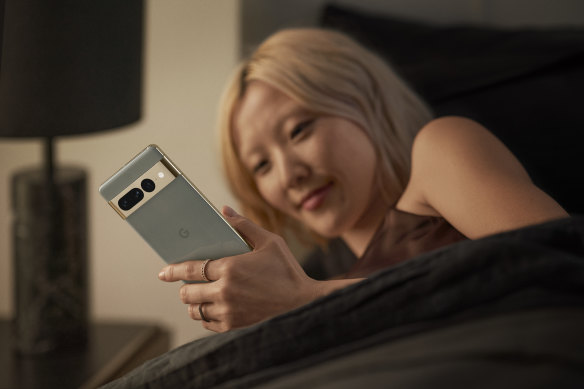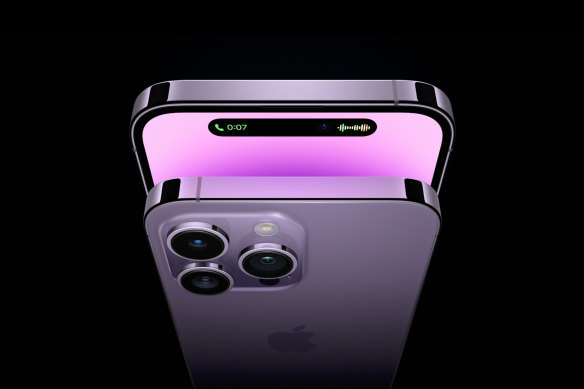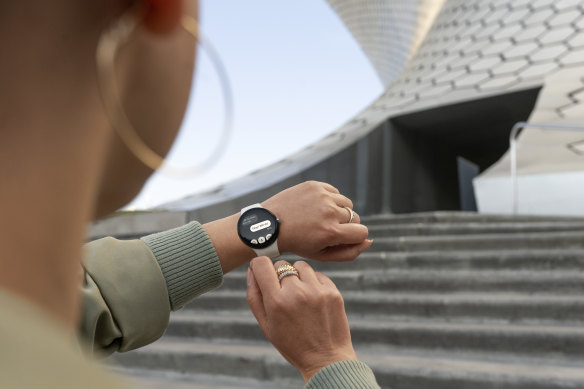
With Google’s new gadgets launching this week, it finally has a suite of smartphones, watches and earbuds to match Apple. But while the devices from the two tech giants are largely comparable in terms of their specs and functions, there are some significant differences when it comes to the details and philosophies.
Starting with the big guns, Google’s Pixel 7 Pro ($1300) is most easily compared to Apple’s iPhone 14 Pro Max ($1900). Both have big 6.7-inch OLED screens with smooth 120Hz refresh rates, brand new 4nm processors and a trio of rear-facing cameras. But each also has its specific strengths.
The Pixel 7 Pro is all about Google’s software and AI tricks.
The iPhone’s steel frame and frosted glass feels nicer than the Pixel’s aluminium and polish, but then the iPhone is also noticeably heavier and harder to use one-handed. The iPhone is brighter in direct sunlight, but the Pixel has a sharper screen.
The Pixel has a lot of RAM to brute force multitasking and game performance, but the custom iPhone more or less matches it and packs a custom GPU for powerhouse graphics rendering and video editing. Unsurprisingly, Google’s processor is tuned to prioritise fast processing of AI tasks.
On the camera side both have huge main sensors that are used for standard shots and 2x zoom. The iPhone takes clear and warm shots and offers a lot of control, while I find the Pixel to be sharper and better at object tracking.
Both are great at 2x zoom but beyond that the Pixel pulls ahead. That’s because the iPhone’s telephoto lens is at 3x, while the Pixel’s is at 5x. When looking at a long zoom like 10x or 15x, Google’s camera holds up where Apple’s does not. To fill in the gap between 2x and 5x, the Pixel will sample both cameras and results are great. Apple and Google both include an ultrawide lens with autofocus, which doubles as a pseudo macro, and both are fine given lots of light.
Apple’s iPhone 14 Pro Max goes for $600 more than the Pixel 7 Pro.
When it comes to AI photo shenanigans, results are split. The Pixel is better and faster at stitching together a legible image in extreme low light, but Apple is more convincing at blurring the background for portrait photos and cinematic video.
Obviously not everybody wants to get the most expensive phone possible, and the two brands differ in their approach to the rest of the lineup. Apple offers the same thing in a smaller frame (the iPhone 14 Pro) for $1400, or a significant step down in design, processor and cameras to the iPhone 14 and 14 Plus at $1400 and $1580 respectively. Google has a more straightforward lineup; the $999 Pixel 7 drops the telephoto lens and is smaller, while the $750 Pixel 6a is smaller still and has last year’s chip and cameras.
Moving to watches, the new $550 Pixel Watch is mainly exciting because it represents Google’s first effort, though it’s clearly ill-suited for a comparison with the supremely refined Apple Watch, now in its eighth generation.
The Pixel Watch is one of the slickest Wear OS watches ever, sliding smoothly between tiles and apps, boasting a range of customisable faces with Apple-style complications, ably tracking workouts and heart rates and even offering fall detection. Pretty much anything you can do with an Apple Watch you can do here, including streaming music directly to earbuds, tapping to make payments and connecting to mobile data networks (with the more expensive cellular model).
The Pixel Watch can put your messages and calls on your wrist, and track your fitness.
But Google plies its own strength on the watch too. The voice assistant and smart home apps are better than Apple’s, and the turn-by-turn Google Maps guidance is awesome for walking and cycling.
But the Apple Watch S8 (from $630) is prettier and more capable. Side by side the Pixel seems slow, and its huge black bezels are very noticeable. Apple’s fitness rings are more digestible and its tracking more complete than the solution provided by Google’s Fitbit, and the Apple Watch’s battery lasts much longer.
It’s a similar story with the Pixel Buds Pro ($300) against the second generation AirPods Pro ($400). Google is less expensive and delivers a product that beats most of its Android contemporaries, but Apple is more experienced in the category. The noise cancellation on the AirPods is more complete, the pinch controls are less prone to accidental touching, but both are comfortable and sound good.
It’s when you look at the ecosystems as a whole that you can see where the big differences are.
Apple makes small iterations each year, but it’s clearly building towards a place where its products are indispensable to navigating the real world as well as the virtual. Its introduction of an always-on display for the iPhone 14 Pro immediately leapfrogged Android’s longstanding implementation with widgets and information that help keep the phone at the centre of your communication, agenda, smart home, entertainment and fitness. Meanwhile, the expanded compass features in its Watch — which let you drop virtual markers and be guided back to them later — and decibel-lowering AirPod tech point to a desire to augment the natural world with tech in a way that would be cumbersome on a phone.
By comparison, the Pixel line has always been about Google showcasing its Android software and artificial intelligence capabilities, and we see that on the latest phones with features like the ability to transcribe voice messages, translate between languages in real time, and make sharp images out of old photos with a lot of motion blur. The move into the smartwatch space is an expansion of this, and shows how Google’s massive mapping, data and AI capabilities can be put to work on people’s wrists. As with Android on phones, this is likely to make for not only more useful Pixel devices in the future, but gear from other manufacturers leveraging (and supporting) Google software as well.
Get news and reviews on technology, gadgets and gaming in our Technology newsletter every Friday. Sign up here.
Most Viewed in Technology
From our partners
Source: Read Full Article


